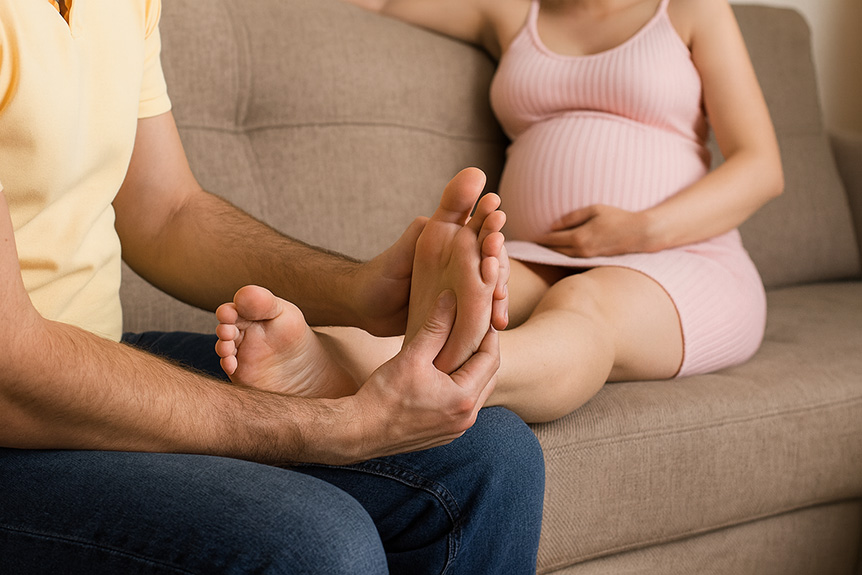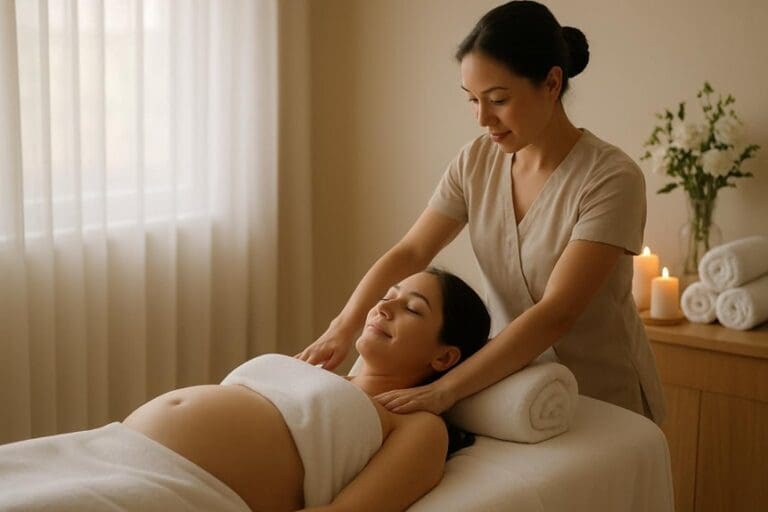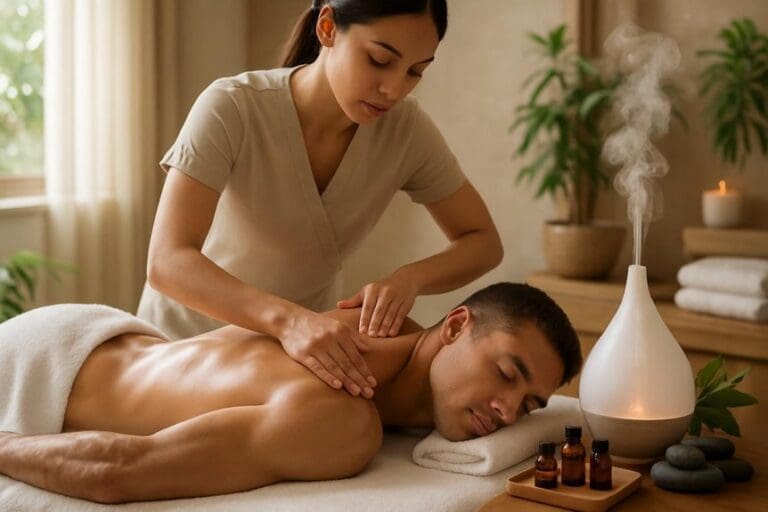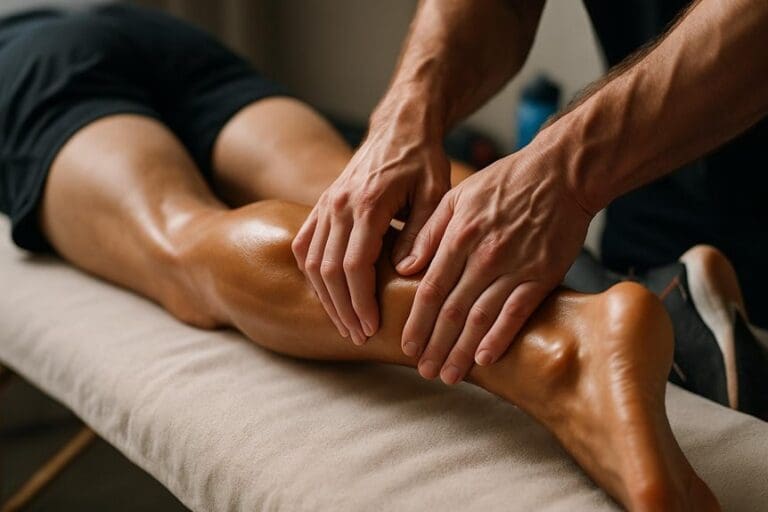During prenatal, it is important to avoid foot massage on the inner ankle (particularly around the medial malleolus), the arch of the foot, and between the big toe and second toe, as these areas correspond to reflexology points linked to the uterus and pelvic organs. Stimulation here may increase the risk of contractions or other adverse reactions. Gentle techniques and communication with healthcare providers are advised. Further guidance clarifies which areas and symptoms may present additional concerns.
Understanding Foot Massage Safety During Pregnancy
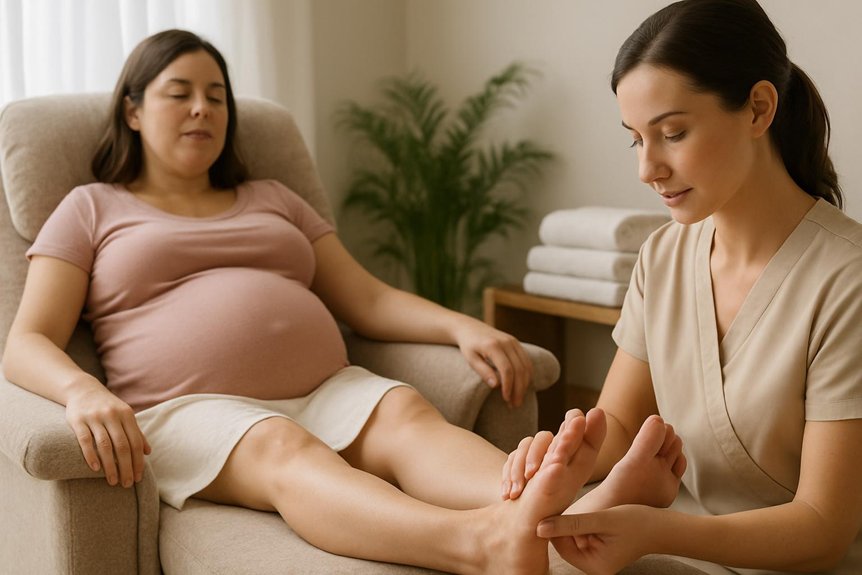
While foot massage can offer relaxation and comfort, its safety during prenatal warrants careful consideration. Clinical evidence suggests that, although gentle foot massage may help alleviate swelling and tension, special precautions are essential due to physiological changes in prenatal, such as increased blood volume and hormone fluctuations affecting tissue sensitivity.
At Spa & Massage, therapists prioritise a thorough consultation to assess individual circumstances, including trimester, medical history, and any complications. Gentle techniques and light pressure are favoured, avoiding deep manipulation that could potentially stimulate uterine contractions or affect circulation.
Clients are encouraged to communicate openly about sensations or discomfort during treatment.
Ultimately, personalised care and professional assessment are key to maximising benefits while minimising risk, ensuring expectant mothers feel nurtured and secure throughout their experience. In contrast to deep tissue massage, which uses more intense pressure and is designed to reach deeper layers of muscle and connective tissue, prenatal foot massage employs only light, gentle strokes to safeguard the well-being of both mother and baby.
Key Pressure Points to Avoid on the Foot
Following a careful assessment of foot massage safety during prenatal, attention must be directed to specific pressure points that warrant caution. Evidence-based practice highlights the importance of avoiding strong stimulation on areas such as the inner ankle (around the medial malleolus), the arch of the foot, and the region between the big toe and second toe.
These points are associated with reflexology zones believed to correspond with the uterus and pelvic organs. At Spa & Massage, therapists are trained to recognise and gently avoid these sensitive zones during prenatal treatments.
Instead, focus is given to soothing, light techniques that enhance relaxation without unnecessary risk. This careful approach supports maternal wellbeing while respecting the unique physiological changes and sensitivities present at each stage of maternity.
Why Certain Areas Are Sensitive in Maternity
Due to physiological and hormonal changes that occur during prenatal, certain areas of the body, including specific regions of the foot, become particularly sensitive and reactive. Increased blood flow, fluid retention, and the release of relaxin lead to changes in tissue elasticity and nerve responsiveness.
This heightened sensitivity means that pressure applied to certain points may produce stronger sensations or discomfort, requiring careful adjustment of massage techniques. At Spa & Massage, therapists are trained to recognise these vulnerable zones and adapt their approach accordingly, ensuring safety and comfort.
Gentle, nurturing touch is prioritised, and deep or targeted pressure on sensitive regions is generally avoided. These measures support the well-being of both mother and baby, fostering a sense of connection while minimising unnecessary risk during each session.
The Role of Reflexology Zones in Prenatal Care
Understanding the heightened sensitivity of certain foot areas during prenatal naturally leads to careful consideration of reflexology zones and their influence on prenatal care.
Reflexology maps the feet into zones believed to correspond with various body systems, and at Spa & Massage, practitioners approach prenatal treatments with particular caution.
Evidence suggests that some reflex points may have an effect on uterine or pelvic function, emphasizing the importance of specialized knowledge when selecting areas for gentle touch.
In our clinics, therapists are trained to adapt reflexology techniques, focusing on zones that promote general relaxation and comfort while carefully avoiding those linked to reproductive or abdominal areas.
This tailored approach helps expectant mothers experience nurturing support, prioritizing their well-being and safety throughout every stage of maternity.
Potential Risks of Stimulating the Wrong Areas
Stimulation of certain reflexology points on the feet during maternity has been associated with potential risks, including unintended uterine activity and changes in blood flow.
Clinical evidence suggests that improper pressure or technique may increase the likelihood of swelling or discomfort. For these reasons, Spa & Massage recommends that only specially trained therapists perform prenatal foot massages, with careful attention to technique and zone selection.
Reflexology Pressure Point Cautions
When considering reflexology during maternity, it is vital to recognise that certain pressure points on the feet may trigger unintended physiological responses. Evidence suggests that specific areas, such as those corresponding to the pelvic region or inner ankles, may influence hormonal or circulatory changes.
At Spa & Massage, therapists are extensively trained to avoid these sensitive points and instead focus on gentle, supportive techniques that enhance overall relaxation without risk. Caution is always prioritised, as professional consensus indicates that improper stimulation can lead to discomfort or heightened anxiety.
Personalisation of each session, based on client feedback and medical history, further reduces potential risks. Clients are encouraged to communicate openly, ensuring that every touch is safe, nurturing, and aligned with best practices for maternity wellness.
Uterine Stimulation Concerns
Although massage therapy offers significant benefits during maternity, there are specific risks associated with stimulating certain areas of the feet that are believed to correspond with uterine activity.
Clinical observations and reflexology principles suggest that pressure applied to regions such as the inner ankles and specific points on the arch may theoretically trigger uterine contractions.
At Spa & Massage, therapists exercise heightened caution, avoiding these zones to prioritise maternal and foetal well-being. While evidence on direct causation is limited, erring on the side of safety is central to our philosophy.
For expectant mothers, seeking massage from skilled practitioners who understand prenatal-specific contraindications ensures a nurturing experience.
In our clinics, each session is carefully tailored, with open communication encouraged, to create a safe, connected environment for every client.
Circulation and Swelling Risks
Many pregnant clients experience changes in blood circulation and fluid balance, with swelling (oedema) in the feet and ankles being a common concern.
During maternity, the body’s increased blood volume and hormonal shifts can slow venous return, making some areas more sensitive to pressure.
At Spa & Massage, therapists are trained to recognise that vigorous or inappropriate foot massage may inadvertently encourage fluid movement or disrupt delicate vessels, potentially increasing swelling or discomfort.
Cautious, gentle techniques are preferred, avoiding deep pressure on swollen areas or where there may be vascular compromise.
Our approach prioritises client safety and comfort, tailoring every session to the individual’s stage of maternity and symptoms.
Clients are encouraged to communicate openly about swelling or tenderness so their care is always personalised and protective.
Professional Guidelines Followed at Spa & Massage
At Spa & Massage, strict safety protocols are in place to protect pregnant clients, including careful screening and modification of treatments.
All therapists receive specialized training in prenatal care to guarantee adherence to best practices and minimize any potential risks.
These standards reflect a commitment to evidence-based, client-centered care during prenatal.
Safety Protocols for Maternity
When providing massage treatments for pregnant clients, Spa & Massage adheres to stringent safety protocols grounded in current clinical guidelines and best practices. Each prenatal massage begins with a thorough consultation to assess medical history, stage of prenatal, and identify contraindications.
Therapists use side-lying or semi-reclined positions, ensuring comfort and ideal circulation. Only gentle, specialized techniques are applied, carefully avoiding deep pressure on areas known to trigger uterine reflexes, particularly in the feet and lower legs.
Approved, hypoallergenic oils are selected to safeguard sensitive skin. Sessions are tailored to each trimester, with ongoing monitoring for signs of discomfort or complications.
Therapist Training Standards
Delivering safe and effective maternity massage relies not only on rigorous safety protocols but also on the advanced training and qualifications of therapists. At Spa & Massage, practitioners undergo specialized education in prenatal care, anatomy, and contraindications unique to prenatal.
This specialized training ensures that each therapist confidently distinguishes which areas of the body—particularly the feet and ankles—require gentle handling or avoidance due to the presence of pressure points linked to uterine stimulation.
Continuous professional development is emphasized, with regular training updates reflecting the latest clinical guidelines. Therapists are taught to recognize signs of risk, such as swelling or discomfort, and to adapt techniques accordingly.
Spa & Massage’s commitment to these standards fosters trust, allowing clients to experience nurturing touch within a framework of clinical safety and informed care.
Safe Alternatives for Foot Relief During Maternity
While foot discomfort is a common concern during maternity, direct foot massage is not always advised due to potential risks associated with certain pressure points. Instead, Spa & Massage recommends safe, evidence-based alternatives to ease foot aches.
Elevating the legs regularly and wearing supportive footwear can reduce swelling and fatigue. Gentle ankle rotations or light stretching, performed at home or under guidance, may provide relief without risk. Warm foot soaks—monitored for temperature—can soothe tired feet and promote relaxation.
Additionally, our therapists often suggest prenatal massage focused on the legs, back, or shoulders, carefully avoiding sensitive foot areas.
These measures, grounded in clinical best practice, offer comfort and support for expectant mothers seeking relief, while prioritising both maternal and fetal wellbeing.
Communicating With Your Therapist About Maternity
Open communication between clients and therapists forms the foundation of safe and effective maternity care. At Spa & Massage, therapists encourage clients to disclose their maternity status and any related symptoms or complications before a session begins. This dialogue allows therapists to adapt techniques, pressure, or avoid certain areas as clinically indicated by evidence-based guidelines.
Clients benefit from sharing details about gestational age, previous pregnancies, or medical advice received from their healthcare provider. Therapists at Spa & Massage are trained to listen attentively and respond with expert, compassionate care, ensuring each treatment is tailored for comfort and safety.
Signs to Stop or Modify a Foot Massage
Recognising when to stop or modify a foot massage during maternity is essential to safeguarding maternal and fetal wellbeing. Signs warranting caution include sudden or severe pain, swelling, numbness, dizziness, unusual warmth, or tenderness in the legs or feet.
If a pregnant client experiences any of these symptoms during a session at Spa & Massage, therapists are trained to pause immediately and reassess. Additionally, unexpected uterine cramping or contractions signal the need to cease.
Clients are encouraged to communicate any discomfort, as even mild symptoms may require adjustment of technique or pressure.
Our therapists recommend gentle, targeted approaches, avoiding known reflexology points linked to uterine stimulation. Prioritising these signs ensures every session remains supportive, nurturing, and aligned with the highest standards of maternity care.
Conclusion
In summary, while the allure of foot massage during maternity is undeniable, the hidden complexities of pressure points and reflex zones demand vigilant care. The question lingers: could an innocent touch trigger unintended consequences? Only with evidence-based guidance and skilled hands can expectant mothers safely indulge in this soothing ritual. As new research emerges, continued caution is warranted—ensuring that every foot massage remains a gentle comfort, rather than an unforeseen risk, along the delicate path of maternity.
